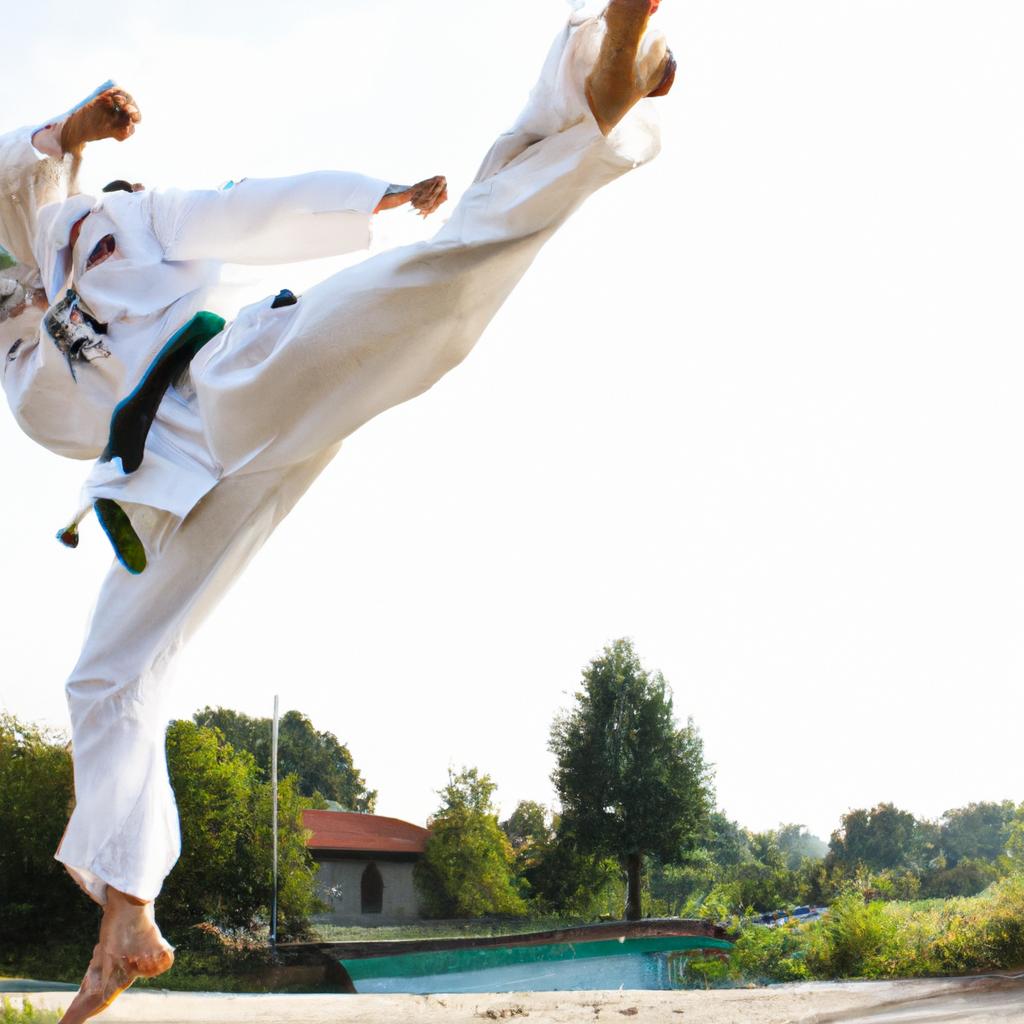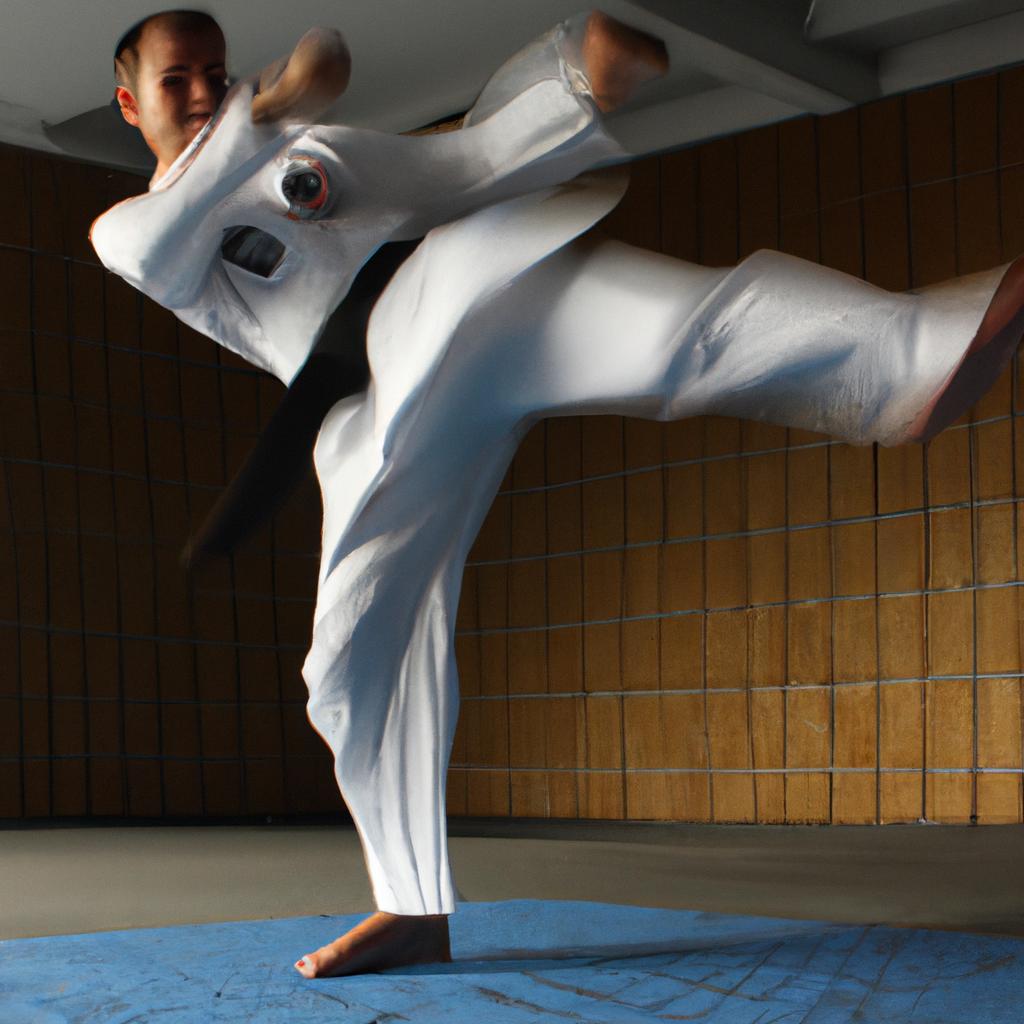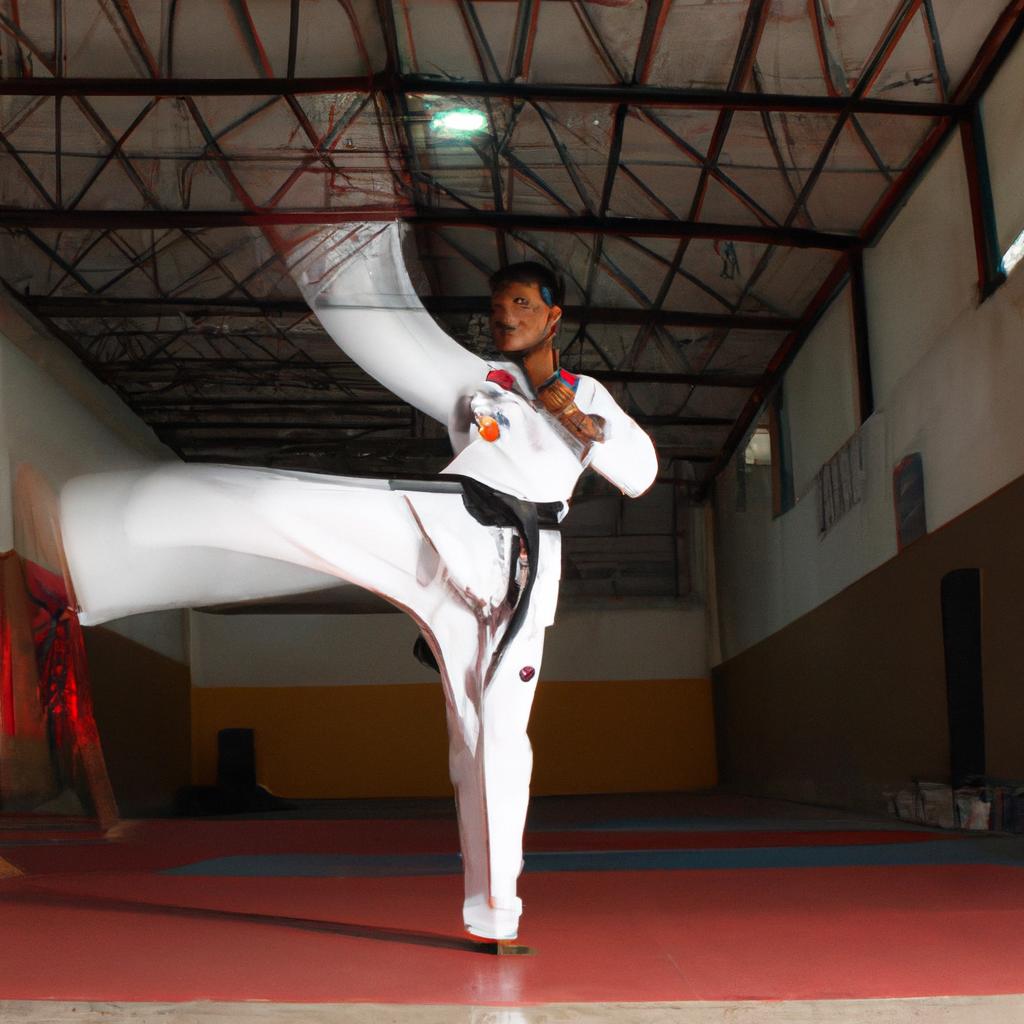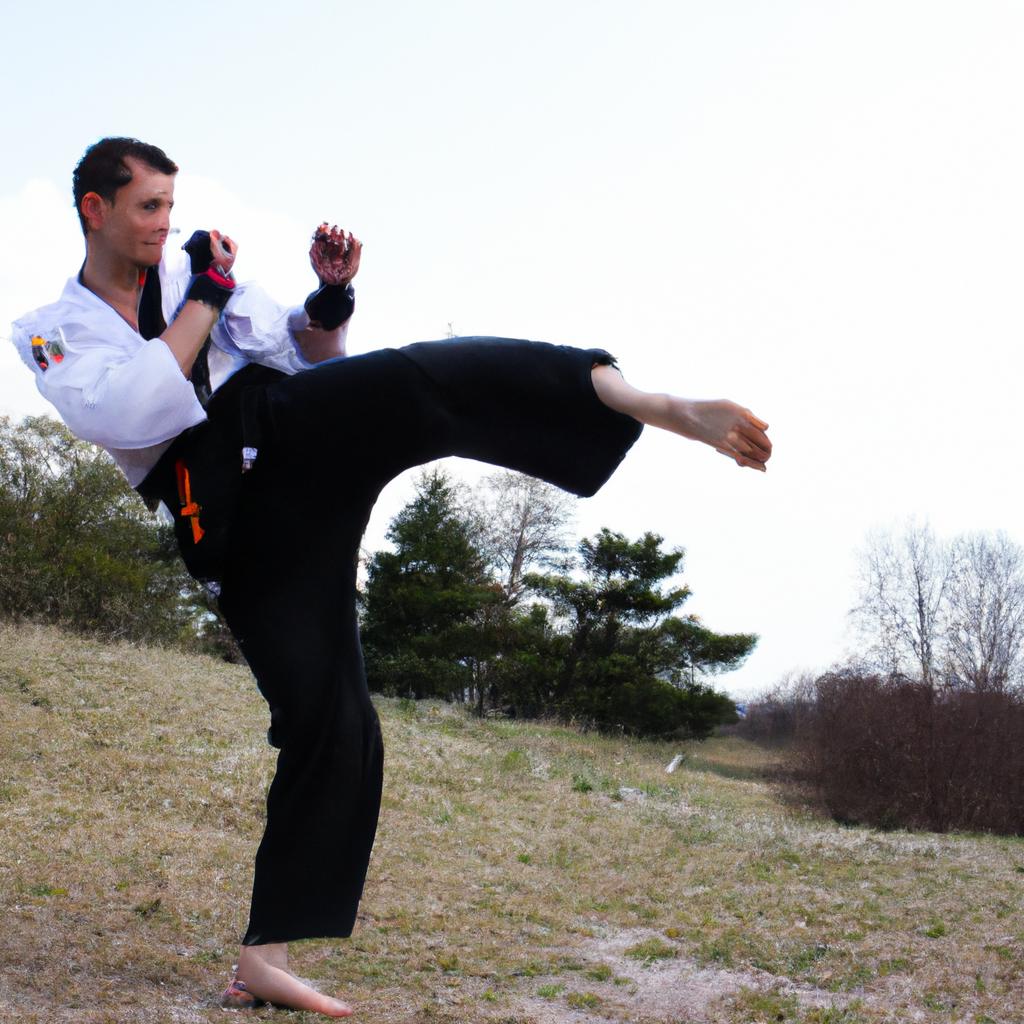In the realm of martial arts, Taekwondo stands out as a dynamic and captivating discipline that combines self-defense techniques with an emphasis on physical fitness and mental fortitude. One particular aspect that sets Taekwondo apart is its incorporation of forms and patterns, which serve as a fundamental component in this ancient Korean martial art. These forms, known as Poomsae in Taekwondo terminology, consist of a sequence of movements executed with precision and fluidity. By unraveling the essence behind these intricate combinations of strikes, kicks, blocks, and stances, we can gain deeper insights into the philosophy and practical application of MMA (Mixed Martial Arts) within the context of Taekwondo.
To illustrate the significance of forms and patterns in understanding the essence of MMA martial arts in Taekwondo, consider a hypothetical scenario where two practitioners engage in a friendly sparring session. The first practitioner possesses exceptional technical skills but lacks knowledge of Poomsae; they rely solely on their athletic abilities to overpower opponents. In contrast, the second practitioner demonstrates not only remarkable athleticism but also an extensive understanding of various forms and patterns in Taekwondo. As they execute each movement with grace and precision, it becomes evident that their mastery goes beyond physical prowess. The second practitioner’s understanding of forms and patterns allows them to seamlessly transition between offensive and defensive techniques, anticipate their opponent’s moves, and strategically position themselves for optimal advantage. Their movements reflect a deep-rooted knowledge of timing, distance, balance, and body mechanics.
The essence of MMA in Taekwondo lies in the ability to adapt and integrate different techniques from various martial arts disciplines seamlessly. By incorporating forms and patterns into their training, practitioners develop a solid foundation in fundamental techniques that can be applied effectively in combat situations. This includes strikes such as punches and kicks, blocks to defend against attacks, footwork to maintain agility and mobility, and stances for stability and power generation.
Furthermore, the practice of Poomsae cultivates discipline, focus, mental resilience, and self-awareness – qualities essential for success not only in martial arts but also in life. Through repetition and refinement of these movements, practitioners enhance their concentration skills while developing a deeper connection between mind and body. This heightened awareness allows them to react instinctively during sparring sessions or real-life self-defense scenarios.
In summary, understanding the essence of MMA within the context of Taekwondo requires embracing the significance of forms and patterns (Poomsae). It is through this practice that practitioners gain a comprehensive understanding of technique execution, strategic positioning, mental fortitude, adaptability, discipline, focus, and self-awareness – all crucial elements that contribute to becoming a well-rounded martial artist.
History and Origins of Taekwondo
History and Origins of Taekwondo
Imagine a small village nestled in the mountains of ancient Korea, where warriors trained diligently to defend their land. One such warrior, named Hwang Kee, sought to unify various martial arts disciplines into one cohesive system that would embody the spirit and traditions of his ancestors. This vision laid the foundation for what we now know as Taekwondo.
To understand the history and origins of Taekwondo, it is essential to explore its roots in Korean martial arts. The earliest records indicate that these combat techniques were developed more than 2,000 years ago during the Three Kingdoms period. Over time, numerous influences from neighboring countries shaped the evolution of Korean martial arts. For instance, Chinese martial arts introduced striking techniques while Japanese styles contributed to defensive maneuvers.
The formalization of Taekwondo took place in 1955 when South Korea’s government officially recognized this art as a national sport. With this recognition came a standardized curriculum and belt grading system, further cementing its status as a distinct discipline within the realm of martial arts.
Taekwondo: A Journey Through Time
- Immerse yourself in the rich cultural heritage of Korea
- Witness the emergence of diverse fighting styles
- Experience the fusion of traditional values with modern training methods
- Discover how perseverance and dedication have transformed lives
| Key Milestones | Notable Figures | Cultural Influences |
|---|---|---|
| Introduction of footwork | Master Hwang Kee | Chinese Martial Arts |
| Development of sparring | General Choi Hong Hi | Japanese Fighting Styles |
| Integration of self-defense | Grandmaster Park Jung Tae | Korean Traditional Values |
As we delve deeper into understanding Taekwondo’s essence, it becomes evident that its journey extends beyond physicality and technique. It encapsulates centuries-old beliefs rooted in respect, discipline, and honor. The disciplined practice of Taekwondo not only strengthens the body but also cultivates mental fortitude and spiritual growth.
Transitioning to the subsequent section on “Fundamentals of MMA Techniques in Taekwondo,” we explore how this ancient art form has embraced modern combat techniques while preserving its traditional values.
Fundamentals of MMA Techniques in Taekwondo
Forms and Patterns: Unveiling the Essence of MMA Martial Arts in Taekwondo
History helps us understand how disciplines evolve over time, but to truly grasp the essence of a martial art like Taekwondo, we must delve into its fundamentals. By exploring the incorporation of Mixed Martial Arts (MMA) techniques in Taekwondo, we can witness how this ancient Korean martial art has adapted to modern combat sports.
Imagine a scenario where two Taekwondo practitioners face each other in a sparring match. Both athletes possess exceptional kicking abilities, honed through years of disciplined training. However, one practitioner excels not just in high kicks but also in grappling techniques derived from MMA. This individual seamlessly transitions between striking and ground fighting maneuvers, catching their opponent off-guard with unexpected takedowns or submission holds. Herein lies the beauty of combining MMA techniques with traditional Taekwondo; it allows for versatility and unpredictability that can be highly advantageous in competitive matches.
To further illustrate this point, consider the following bullet-point list:
- Incorporating MMA techniques adds another layer of complexity to Taekwondo’s already dynamic fighting style.
- The integration of grappling moves enhances fighters’ ability to control opponents on the ground.
- Utilizing joint locks and submissions provides opportunities for swift victories without relying solely on strikes.
- The inclusion of wrestling-based strategies enables practitioners to exploit gaps left by opponents unaccustomed to such tactics.
Now let us explore these points more comprehensively through a table:
| Enhanced Versatility | Improved Ground Control | Expanded Finishing Options |
|---|---|---|
| Adds new dimensions | Greater command | Offers alternative paths to victory |
| Increases tactical options | Enhances defensive capabilities | Provides surprises for adversaries |
| Challenges competitors | Limits opponents’ movements | Requires adaptability |
In conclusion, the integration of MMA techniques in Taekwondo not only diversifies its fighting style but also equips practitioners with a broader skill set. By incorporating elements such as grappling, joint locks, and wrestling-based strategies, this fusion enables fighters to adapt to different combat situations effectively. In our subsequent section on the Importance of Forms and Patterns in Taekwondo, we will explore how these core aspects contribute to the overall development of martial artists.
Transitioning into the next section about “Importance of Forms and Patterns in Taekwondo,” we can now delve deeper into understanding how these fundamental components shape a practitioner’s journey towards mastery.
Importance of Forms and Patterns in Taekwondo
Forms and Patterns: Unveiling the Essence of MMA Martial Arts in Taekwondo
- Importance of Forms and Patterns in Taekwondo
Having established a foundation in the fundamentals of MMA techniques within Taekwondo, it is now crucial to delve into the significance of forms and patterns as integral components of this martial art discipline. By understanding their importance, practitioners can fully grasp how these elements contribute to the development of well-rounded skills.
Forms and patterns are structured sequences of movements that encompass a range of techniques across various stances and positions. They serve as an embodiment of traditional martial arts principles while highlighting practical applications for combat scenarios. To illustrate their value, let us consider a hypothetical case study involving two taekwondo practitioners with contrasting training approaches.
Case Study:
- Practitioner A focuses solely on sparring sessions without dedicating time to practicing forms or patterns.
- Practitioner B dedicates equal attention to sparring and mastering intricate forms and patterns.
The benefits derived from incorporating forms and patterns become evident when comparing the performance levels of both practitioners. While practitioner A may possess refined sparring skills, they lack finesse in executing precise techniques during specific situations. Conversely, practitioner B demonstrates greater versatility by seamlessly transitioning between different combinations inspired by diverse forms and pattern movements.
To further emphasize the significance of forms and patterns, consider the following emotional responses often evoked among taekwondo practitioners:
Emotional Responses:
- Sense of Discipline: Consistently practicing forms instills self-discipline through repetition, allowing individuals to overcome challenges outside their comfort zones.
- Connection with Tradition: Engaging with centuries-old movements connects practitioners to the historical roots and cultural heritage associated with taekwondo.
- Inner Focus and Meditation: Performing intricate forms requires deep concentration, providing opportunities for mindfulness practice.
- Self-expression and Artistry: Integrating personal style within form execution allows individuals to express their unique identities and creativity.
The importance of forms and patterns in taekwondo can also be understood through a comparison table showcasing the benefits they offer:
| Benefits | Forms and Patterns |
|---|---|
| Development of Balance | ✓ |
| Enhancement of Flexibility | ✓ |
| Improvement of Coordination | ✓ |
| Strengthening of Technique | ✓ |
As we delve into training methods for developing MMA skills in taekwondo, it is crucial to recognize that forms and patterns serve as vital tools in cultivating a well-rounded martial artist. They provide practitioners with a solid foundation, enabling them to enhance balance, flexibility, coordination, and technique while fostering a sense of discipline, tradition, inner focus, self-expression, and artistry.
With an understanding of the significance of forms and patterns established, let us now explore the various training methods employed for developing MMA skills within the realm of taekwondo.
Training Methods for Developing MMA Skills in Taekwondo
Transitioning seamlessly from the importance of forms and patterns in Taekwondo, we now explore how training methods can be employed to develop MMA skills within this traditional martial art. To illustrate this concept, let us consider a hypothetical scenario involving an experienced Taekwondo practitioner named Sarah.
Sarah has been practicing Taekwondo for several years and wishes to enhance her skills by incorporating elements of Mixed Martial Arts (MMA) into her training regimen. By integrating techniques such as grappling, ground fighting, and striking from various disciplines like Brazilian Jiu-Jitsu and Muay Thai, she aims to become a more well-rounded martial artist.
To effectively develop MMA skills within the framework of Taekwondo, practitioners can employ the following strategies:
- Cross-training: Engaging in supplementary training sessions with instructors or experts specializing in specific areas of MMA can provide valuable insights and experiences that are not typically emphasized in traditional Taekwondo classes.
- Sparring adaptations: Modifying sparring drills to incorporate aspects of MMA allows practitioners like Sarah to practice transitioning between different ranges of combat while applying their Taekwondo techniques effectively.
- Strength and conditioning: Focusing on strength and conditioning exercises tailored towards improving stamina, power, agility, and overall physical fitness is crucial for successfully executing MMA techniques during intense competitions or self-defense situations.
- Mental preparation: Cultivating mental resilience through visualization exercises, meditation practices, and stress management techniques helps individuals like Sarah stay calm under pressure and make effective decisions during fast-paced MMA scenarios.
To further understand the integration of these concepts within the context of Taekwondo’s evolution into mixed martial arts, consider the following table highlighting key changes over time:
| Era | Key Developments | Impact on Taekwondo |
|---|---|---|
| Early Stages | Introduction of ground fighting techniques | Expansion of Taekwondo’s combat strategies |
| Modernization | Incorporation of Brazilian Jiu-Jitsu principles | Enhanced adaptability and versatility |
| Contemporary | Integration of MMA training methods | Evolution into a comprehensive martial art |
Considering the evolving nature of MMA martial arts in Taekwondo, it is evident that practitioners like Sarah can benefit greatly from embracing this fusion. By combining traditional forms and patterns with the dynamic techniques found in MMA, individuals are empowered to develop a well-rounded skill set capable of adapting to various combat scenarios.
Transitioning into the subsequent section about the evolution of MMA martial arts in Taekwondo, we delve deeper into the historical context and societal influences that have shaped this transformation.
Evolution of MMA Martial Arts in Taekwondo
As taekwondo continues to evolve, it has embraced various aspects of mixed martial arts (MMA) to enhance its effectiveness as a combat sport. The integration of MMA techniques into traditional taekwondo training methods has paved the way for a more dynamic and versatile approach to competitions. To illustrate this, let us consider an example of how MMA techniques have revolutionized sparring sessions within the realm of taekwondo.
Imagine a taekwondo practitioner who excels in high kicks but struggles when engaging in close-quarters combat. By incorporating grappling techniques from MMA, such as clinching and takedowns, this practitioner can develop a well-rounded skill set that complements their existing strengths. They would be able to apply these new techniques strategically during sparring, creating opportunities to neutralize opponents who excel at maintaining distance.
The impact of integrating MMA techniques into taekwondo extends beyond individual case studies. Here are some key benefits that arise from this fusion:
- Increased adaptability: The incorporation of MMA techniques allows practitioners to adapt swiftly to different fighting styles encountered in competitive environments.
- Enhanced offensive capabilities: By combining striking and grappling skills, athletes gain a wider range of attacks and counters, expanding their arsenal during contests.
- Improved defensive strategies: Incorporating elements like wrestling or Brazilian Jiu-Jitsu empowers practitioners with effective defensive maneuvers, enabling them to evade or escape unfavorable situations.
- Heightened physical conditioning: Training in both traditional taekwondo movements and MMA techniques challenges athletes’ endurance, strength, agility, and flexibility on multiple levels.
To emphasize the significance of this fusion further, we present the following table showcasing specific examples of how MMA techniques influence different aspects of taekwondo practice:
| MMA Technique | Impact on Taekwondo Practice |
|---|---|
| Clinching & Takedowns | Enhanced close-range combat skills |
| Ground Fighting | Improved ability to defend and escape from ground positions |
| Submission Holds | Expanded repertoire of submission techniques for both offense and defense |
| Mental Toughness Training | Developing resilience, adaptability, and a fighting spirit |
As taekwondo continues its evolution with the integration of MMA techniques, it becomes evident that this fusion has transformed the landscape of competitive sparring. The resulting combination enhances athletes’ overall skill sets while providing opportunities for strategic innovation within the realm of taekwondo competitions.
Moving forward, let us explore how these newly acquired MMA techniques have impacted the dynamics of taekwondo competitions in recent years.
Impact of MMA Techniques on Taekwondo Competitions
The Intersection of Traditional Forms and Modern Techniques
As the influence of Mixed Martial Arts (MMA) continues to permeate various martial arts disciplines, it is crucial to explore how this phenomenon has impacted the practice of Taekwondo. By examining the evolution of MMA within Taekwondo, we can uncover new insights into the integration of traditional forms with modern techniques.
To illustrate this intersection, let us consider a hypothetical case study involving a seasoned Taekwondo practitioner named Emma. Recognized for her exceptional mastery of traditional forms, Emma faced an opponent well-versed in MMA during a recent competition. This encounter showcased the intricate interplay between traditional Taekwondo movements and MMA techniques.
Significantly, when facing her MMA-trained opponent’s grappling maneuvers, Emma seamlessly incorporated elements from traditional patterns such as Taegeuk Il Jang into her defense strategies. By utilizing precise footwork and swift hand strikes found in these foundational forms, she effectively countered her opponent’s attempts at close-range combat.
This exemplifies one way in which practitioners like Emma have embraced both their Taekwondo roots and the dynamic nature of modern martial arts. Through this synergy, they are able to adapt their training methodologies while preserving the essence of tradition.
Implications for Training Approaches
The incorporation of MMA techniques within Taekwondo competitions has sparked discussions about optimal training approaches for practitioners seeking versatility on multiple fronts. To better understand these implications, let us examine some key considerations:
- Balancing Familiarity with Innovation: It becomes critical for instructors and athletes alike to strike a balance between maintaining familiarity with traditional forms and embracing innovative techniques borrowed from other disciplines.
- Expanding Skill Sets: The introduction of MMA-inspired techniques provides opportunities for practitioners to expand their skill sets beyond what traditional Taekwondo training alone can offer.
- Adapting Teaching Methodologies: Instructors must adapt their teaching methodologies to encompass a broader range of techniques, ensuring that students are equipped to handle the evolving landscape of martial arts competitions.
- Enhancing Physical Conditioning: The integration of MMA elements necessitates an increased focus on physical conditioning, enabling practitioners to withstand the demands of both striking and grappling exchanges.
Table: Examples of Traditional Forms and MMA Techniques in Taekwondo
| Traditional Form | MMA Technique |
|---|---|
| Taegeuk Sam Jang | Ground-and-pound |
| Palgwe Oh Jang | Clinch |
| Koryo | Submission holds |
| Yudanja Charyeot | Muay Thai techniques |
Note: This table demonstrates how traditional forms in Taekwondo can be aligned with specific aspects of MMA techniques.
In conclusion, the integration of MMA within Taekwondo brings forth new possibilities for practitioners seeking to enhance their martial arts repertoire while preserving the essence of traditional forms. By exploring this intersection between tradition and modernity, we gain valuable insights into training approaches that allow individuals like Emma to navigate the dynamic landscape of today’s martial arts competitions successfully.




